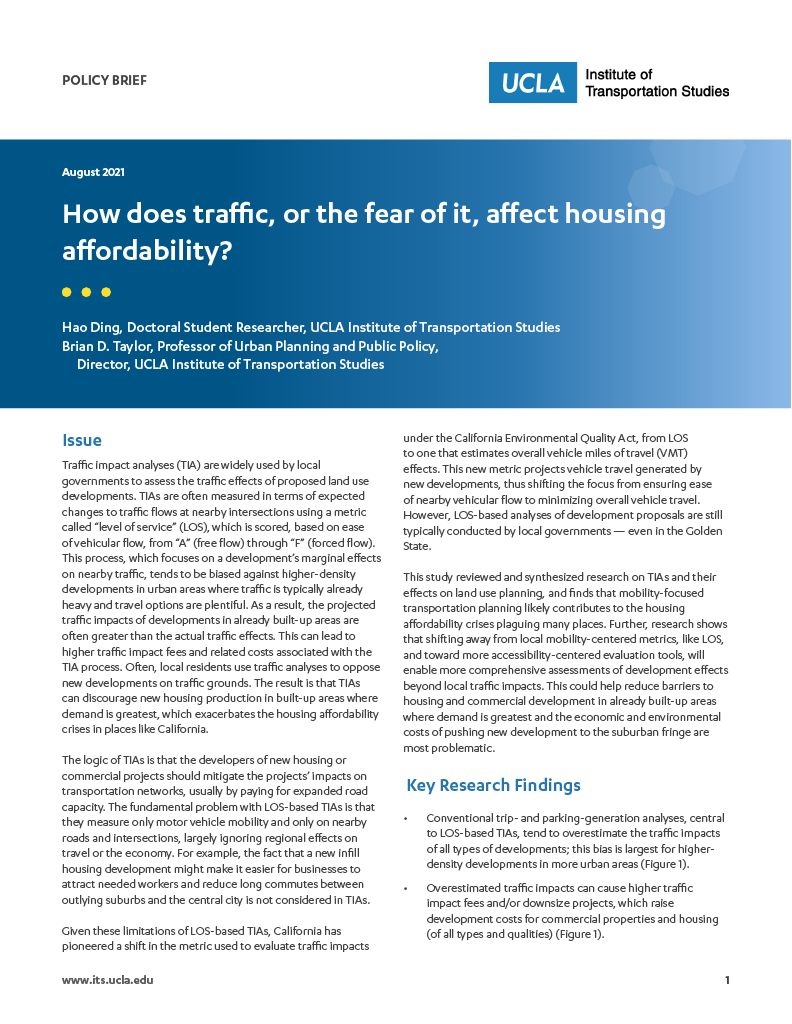Project ID:
LA2039Year Completed:
2020Funding Source:
Statewide Transportation Research ProgramProject Description
For decades evaluation of the benefits and costs of new- or re- development in urban areas has centered on the effects of development on nearby traffic flows. Historically, and in most states outside of California, if traffic impact analyses determine that a proposed housing or commercial development unacceptably degrades traffic level-of-service (LOS) on nearby streets, the proposed development will not be approved by local governments unless and until the traffic effects of the new development are mitigated, typically either by reducing the scale of the proposal, or by making improvements (often in the form of capacity expansions) to nearby roads or intersections. The logic of such an evaluation model is that smooth traffic flows are a primary, even central, goal of urban areas, which has the effect of discouraging the sorts of densely developed places that are more easily accessed by foot, bike, shared mobility, and public transit, and pushing developments to greenfields on the suburban fringe where marginal impacts of added traffic are small.
To overcome the traffic flow focus of traffic impact analyses, the California legislature passed and then-Governor Brown signed SB 743 in 2013, which mandated a change in the way that transportation impacts are analyzed under CEQA. In the six years since, the Governor’s Office of Planning and Research promulgated new CEQA Guidelines to replace LOS with a new focus on how proposed developments affect vehicle miles of travel (VMT), where less VMT per capita (and more travel by means other than driving) is better, and more driving is worse. These new guidelines were finalized only last year, so their effects in practice are not yet well known.
While most observers agree that a new focus on VMT offers a more holistic picture of transportation impact than LOS-focused analyses, the new analytical model still centers on adjacent road networks (traffic flow with the former, and less driving with the latter) largely distinct from the how the proposed development might be expected to benefit cities generally, and agglomerations of activities specifically. In other words, the “impacts” of development are still evaluated in terms of reducing many of the negative environmental externalities of (auto) mobility, and not in terms of how development affects accessibility.
Yet a large and growing body of research argues against focusing on mobility (whether to improve the driving experience traditionally or to discourage driving more recently) rather than access to destinations in evaluating the role of transportation systems in urban systems (see for example, Levine, Grengs, and Merlin 2019; Levinson 2016; Levinson, Marshall, and Axhausen 2017; Levinson and King 2019). These works by eminent transportation scholars suggest that the move in California from LOS to VMT is a step in the right direction, but not the last step. A more conceptually complete and practical accessibility impact analysis tool is needed to better understand the effects of development on urban systems.
Publications

Brian D. Taylor (PI)
btaylor@ucla.edu
Program Area(s):




